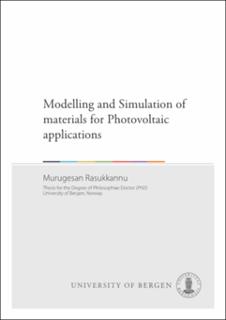| dc.contributor.author | Rasukkannu, Murugesan | |
| dc.date.accessioned | 2019-05-03T11:30:26Z | |
| dc.date.available | 2019-05-03T11:30:26Z | |
| dc.date.issued | 2019-01-09 | |
| dc.identifier.uri | https://hdl.handle.net/1956/19451 | |
| dc.description.abstract | The global need for energy is predicted to double by 2050 and triple by the end of the 21st century. Today, fossil fuels are the primary source for energy supply in the world. However, the excessive consumption of fossil fuels has led to global warming and has resulted in severe environmental impacts. Growing population demands a lot of energy in the future, and there will be limited fossil fuels resources available. Thus, alternative clean energy resources will be the hour of need. Solar energy is probably the most promising source of clean and abundant energy that we have now. An enormous technological and political effort has been undertaken to harness the solar energy more directly. However, the challenge is that solar energy technologies should become cheaper, flexible, energy effective and harmless to the environment. This research focuses on materials for new generation solar cell technologies that fulfil these demands. Third generation solar cells such as intermediate band solar cells and non-silicon solar cells are a newer type of solar cells. They have attained considerable attention in the last two decades, as a potentially cost-effective alternative to conventional costly silicon solar cells. Intermediate band solar cells and non-silicon solar cells are complex devices, which is relied on the interplay of several key components. The unique architecture of intermediate band solar cells provides balancelimiting efficiencies of 63.2%. As a result, an extensive and increasing amount of research effort has been devoted to design and synthesize novel materials. However, most of such efforts have been expensive and time-consuming synthesis procedure. To overcome this drawback, modelling and simulation of new materials is a better method to study and verify the properties of the materials for photovoltaic applications. This thesis has focussed on a theoretical calculation of properties like structural prediction, electronic structure, optical properties, structural stability and mechanical stability behaviour of photovoltaic materials. The aim of the study is fivefold: The first is to study and gain knowledge on the fundamental properties of the matter governed by the electronic structure of a variety of bulk materials. The second is to study novel materials and determine the adaptability and the applicability of theoretical calculation as an accompaniment to experiments for the material scientist in his/her search for novel photovoltaic materials. The third is to investigate materials numerically with intermediate bandgaps that could pave the way for higher cell efficiencies than the theoretically limited efficiency of 32%. Fourth is to carry out an in-depth analysis of low-cost, direct band gap, non-silicon materials for PV applications. Fifth is to implement efficient approximations, methods and algorithms to derive accurate numerical results for electronic and optical properties of a variety of novel materials for PV applications. We expect these findings of novel materials in this thesis will lead to immediate concern and interest to an extensive audience in the scientific society. | en_US |
| dc.language.iso | eng | eng |
| dc.publisher | The University of Bergen | en_US |
| dc.relation.haspart | Paper I: Computational modeling of novel bulk materials for the intermediate-band solar cells. Murugesan Rasukkannu, Dhayalan Velauthapillai, Ponniah Vajeeston ACS Omega 2, no. 4 (2017): 1454-1462. The article is available in the main thesis. The article is also available at: <a href="http://dx.doi.org/10.1021/acsomega.6b00534" target="blank">http://dx.doi.org/10.1021/acsomega.6b00534</a> | en_US |
| dc.relation.haspart | Paper II: Hybrid density functional study of Au2Cs2I6, Ag2GeBaS4, Ag2ZnSnS4 and AgCuPO4 for the Intermediate band solar cells. Murugesan Rasukkannu, Dhayalan Velauthapillai, Ponniah Vajeeston. Energies, 2018;11(12):3457. The article is available in the main thesis. The article is also available at: <a href="https://doi.org/10.3390/en11123457" target="blank">https://doi.org/10.3390/en11123457</a> | en_US |
| dc.relation.haspart | Paper III: A first-principle study of the electronic, mechanical and optical properties of inorganic perovskite Cs2SnI6 for intermediate-band solar cells Murugesan Rasukkannu, Dhayalan Velauthapillai, Ponniah Vajeeston Materials Letters 218 (2018): 233-236. The article is available in the main thesis. The article is also available at: <a href="https://doi.org/10.1016/j.matlet.2018.02.034" target="blank">https://doi.org/10.1016/j.matlet.2018.02.034</a> | en_US |
| dc.relation.haspart | Paper IV: Properties of novel non-silicon materials for the photovoltaic applications: A first-principle insight. Murugesan Rasukkannu, Dhayalan Velauthapillai, Federico Bianchini, Ponniah Vajeeston. Materials 11 (2018): 2006. The article is available in the main thesis. The article is also available at: <a href="https://doi.org/10.3390/ma11102006" target="blank">https://doi.org/10.3390/ma11102006</a> | en_US |
| dc.relation.haspart | Paper V: A promising high-efficiency photovoltaic alternative non-silicon material: A first-principle investigation. Murugesan Rasukkannu, Dhayalan Velauthapillai, Ponniah Vajeeston Scripta Materialia 156 (2018): 134-137. The article is available in the main thesis. The article is also available at: <a href="https://doi.org/10.1016/j.scriptamat.2018.07.027" target="blank">https://doi.org/10.1016/j.scriptamat.2018.07.027</a> | en_US |
| dc.relation.haspart | Paper VI: First-principle calculation of high absorption-TlGaTe2 for photovoltaic application. Murugesan Rasukkannu, Dhayalan Velauthapillai, Federico Bianchini, Ponniah Vajeeston. Full text not available in BORA. | en_US |
| dc.relation.haspart | Paper VII: Bandgap engineering in CsSnxPb (1-x)I3 and their influence on light absorption. Murugesan Rasukkannu, Dhayalan Velauthapillai, Ponniah Vajeeston Materials Letters 218 (2018): 253-256. The article is available in the main thesis. The article is also available at: <a href="https://doi.org/10.1016/j.matlet.2018.02.021" target="blank">https://doi.org/10.1016/j.matlet.2018.02.021</a> | en_US |
| dc.rights | Attribution CC BY. This item's Creative Commons-license does not apply to the included articles in the thesis. | eng |
| dc.rights.uri | http://creativecommons.org/licenses/by/4.0 | eng |
| dc.title | Modelling and Simulation of materials for Photovoltaic applications | en_US |
| dc.type | Doctoral thesis | |
| dc.rights.holder | Copyright The Author | en_US |
| dc.identifier.cristin | 1651801 | |

